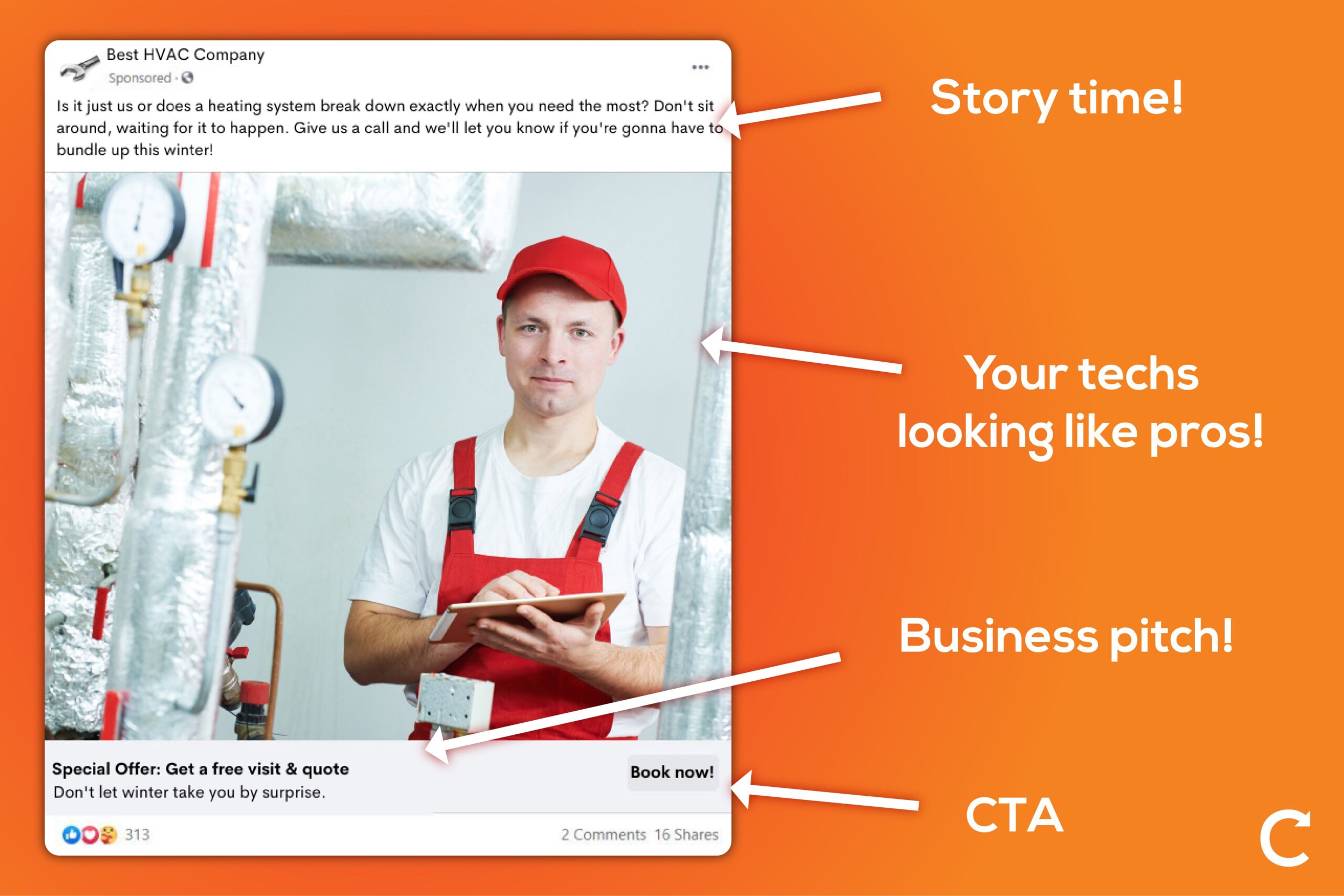HVAC Facebook advertising can help boost your branding and get in touch with potential customers. Especially local customers actively searching for HVAC services. Gone are the days when people only had a few field service or maintenance companies to choose between.

Nowadays, you’ve got to make sure that your business’s voice is heard above the never-ending competition, especially when you’re competing for the same clientele.
Here at Commusoft, we always try to let the experts talk. So, to get you the best advice there is for your industry, we’ve gotten Lyle Horst, HVAC entrepreneur (and marketing expert) to tell us a few of his secrets. If you want all of them, you’ll have to get in touch with him here.
Some more about our host, Lyle Horst (Systemized Media)
Lyle has been running Systemized Media, an HVAC marketing agency since 2010. After seeing just how much his advice had helped increase the revenues of his clients, he decided, together with his business partner, to start his own HVAC company.
Fast forward six months and Topline Heating and Air have made over $500,000 in revenue! Lyle’s success is also attributed to showcasing testimonials from satisfied customers, which helps build trust and credibility with potential clients.
After interviewing Lyle for our web series, Let’s Talk, we reached the unsurprising conclusion that he’s doing a lot of things right. Head over to our YouTube channel or hit play below if you want to learn about all of them.
But one aspect of Lyle’s success really stood out as valuable advice for anyone running an HVAC business, large or small: HVAC Facebook Advertising.
If you want to read more about the reasons why having an HVAC Facebook ad strategy is great for business growth, check out this article. While it mainly addresses plumbing companies, the insights here can be applied to any trade business, so make sure to give it a go.
However, if you’re ready to get down to business and walk away knowing exactly what your first HVAC Facebook ad should look like, keep on reading!
1. Introduction to Facebook Advertising for HVAC Business
Facebook advertising is a powerful tool for HVAC businesses. It helps them to reach new customers, increase brand awareness, and drive sales. With over 2.7 billion monthly active users, Meta provides a vast platform for HVAC companies to showcase their services and products. By creating effective Facebook ad campaigns, HVAC businesses can target specific audiences, increase website traffic, and generate leads.
The beauty of Facebook advertising lies in its ability to reach a highly targeted audience. Whether you’re aiming to attract homeowners in need of HVAC repair or businesses looking for maintenance contracts, Facebook’s sophisticated targeting options allow you to zero in on your ideal customers. This means your ads are seen by the people most likely to need your services. Thus, increasing the chances of conversion.
Moreover, HVAC Facebook advertising can help companies increase brand awareness. By consistently appearing in the feeds of potential customers, your business stays top-of-mind. This is crucial in a competitive market where customers have many options. When they need HVAC services, they’ll remember your brand and be more likely to reach out.
2. How to Start Advertising Your HVAC Business on Facebook
“They chose us for a $27,000 installation before we even walked through the door.”
Who wouldn’t want to be able to say that of their trades business?
Lyle attributes this to Topline Air and Heating’s excellent Facebook Ads strategy and goes on to add that if you want to grow, you have to invest: there’s no way around it.
Since you’re reading this, we’re going to assume you want to grow. We’re also going to assume this is your first proper step into HVAC Facebook advertising. The first thing you need to do, regardless of the size of your company, your budget, or whether you’ve advertised before, is to sit down and plan a couple of different versions of an ad.
In addition to image ads, video ads are highly effective in engaging potential customers and driving conversions. This is so that you can use these variants to do a split test (also known as A/B testing). For beginners, this is an excellent way to gauge your audience’s reaction and see what they respond to best.

3. What to put in your Facebook Ads
Now that you’re ready to create an HVAC Facebook ad, what exactly should you put in it? Well, as you no doubt guessed, you’re going to need a winning combo of images and text, so let’s break down what you’ll need to consider for both:
The Images
The first element you have to choose is visual. Which type of photos or videos represent your company best? Think of why potential clients should pick you over someone else – excellent customer service, local operations, or potential discounts. Make it easy for the customer to relate the imagery back to their needs.
A close-up of a boiler or an AC unit is going to draw the attention of another tradesman, but it might go over the customer’s head as to why that’s such a good example of quality work. Instead, try capturing the bigger picture and show a homey space, a clean installation, and a happy customer.
The Text
Once you have the visual aspects down, it’s time to move on to the text. It shouldn’t surprise you, but these might take some time to perfect and you’ll most likely tweak them with every batch of ads you publish. A good place to start is by telling a story that’s relevant to the customer and finding a way to appeal to their emotions. Self-preservation is a good one, or even increased home value. Whatever route you take, you’ll be able to tell what works best if you’re analyzing the results.
At the bottom of the ad goes your hook. What’s in it for the customer? This could be a free quote, a 10% discount, or a next-day/same-day appointment. Anything goes as long as you’re able to follow through followed by a “Book now!” button.
4. How Much Should You Spend on HVAC Facebook Advertising?
Budgeting your marketing expenses is never easy – and it often comes down to how much you’re willing to invest in the growth of your business. Setting a clear ad budget is essential to ensure that your marketing expenses are well-managed and effective.
While traditional advertising does have its advantages, with digital, you can make sure that it’s targeting the right audience. These days, you can argue that digital marketing is seen more than traditional with the amount of time people spend on smart devices daily.
When calculating your HVAC Facebook ads budget, it’s good to start small. If you’re following our previous advice of creating a few variations of the same advertisement and A/B testing it, then $20 – 50 spread over a week should be enough to gauge which one does better.
In the end, analyze what went well and what didn’t. You can then improve and repeat for the next time. A Facebook audit will always come in handy. According to Databox’s article on performing Facebook audits, “this is an analysis of an Ads account’s best practices and effectiveness. Someone who performs an audit aims to look for strengths and areas of improvement to inform their strategy moving forward.”
5. Risks of Advertising on Facebook
As with anything else, great things come at a certain risk. HVAC Facebook advertising is a matter of trial and error. Sometimes you’ll get it right and sometimes you won’t. It’s important to optimize your ads for Facebook users, many of whom access the platform via mobile devices. At the same time, advertisements should look like any other post. Pretty much anyone can like, share, and, most importantly, comment.
Potential for Negative Feedback
Getting a lot of engagement on your ad is ideal, as this will push it even further. This can potentially get you more bang for your buck, but at the same time, feedback can also be negative. A disgruntled customer (don’t worry, everyone has them) can try to upstage your ad.
In this situation, the best thing to do is to transform the challenge into an opportunity. Answering a negative comment with a thoughtful response that acknowledges the situation. It can demonstrate that you’re making an effort to put the customer experience first. Responding in this way is a great way to provide strong social proof of your professionalism and that can make a big impact on any customer who’s looking to hire you.
Deciding Between HVAC Facebook Advertising and Google Ads
Another thing that Lyle highlighted, not necessarily as a risk, but as a decision that you’ll have to make by weighing the pros and cons – is whether Facebook advertising (and other social outlets) is worth investing in over Google Ads.
The general view is that social media marketing is more preventive, targeting customers that can take their time making a decision, without being rushed by an emergency. On the other hand, paying for Google Ads is what ensures that you’re at the top of the results page when someone’s in a hurry (maybe a pipe just burst). Facebook ads are great for building brand awareness. However, search ads on Google can drive immediate sales by appearing prominently in search results.
This decision is going to fall down to the type of business you’re running. If you’re able to handle emergencies and unplanned appointments, this can be quite a lucrative business. This is because people won’t be thinking about money when their house is getting flooded. Not to mention the good word-of-mouth exposure gained from being the one to get them out of a tough situation.
At the same time, Google Ads are getting increasingly expensive, as is the competition for the same keywords (e.g. Chicago HVAC company, emergency HVAC technician, etc.) grows.
From Lyle’s point of view, there’s hardly any discussion on the topic: he’s firmly in favor of HVAC Facebook advertising, as it helps establish a company in the customer’s mind both in preventive and reactive situations.
“If you’ve already seen our ads on Facebook, maybe you’ve even had a free quote from us, when there’s an emergency, we’re going to be top of mind.”
The question of Googling an HVAC company won’t even arise. As always, you can test out both and see which one does better. You can either choose one or split your budget between the two.
An Influx of Leads
One particular risk many HVAC managers oversee when advertising on Facebook is that the potential for success is higher than they expect. Now, that doesn’t sound like a bad thing at all, does it? Lots of leads coming your way is great, but only IF you have a way of storing their information and converting them into paying customers.
For example, HVAC Facebook ads make it incredibly simple to add a “Book now!” button. All a potential lead has to do is click it, right? However, if that button takes them to a page where there’s only a phone number listed, they might not want to go any further. As a result, that means you’ve paid Facebook for the click-through on the ad, but lost the potential customer because the follow-up was optimized. That’s money down the drain.
6. How to Organize HVAC Facebook Ad Leads
Before you even start HVAC Facebook ads, it’s important to have a plan for the incoming leads. Otherwise, you might end up wasting a lot of money and confusing customers who saw your advert but couldn’t actually schedule a booking.
Using lead ads can simplify the process of capturing potential customer information directly from Facebook.
Automatic Booking Portal
If you’re in the situation highlighted above, where the only way to book is via a phone call that interrupts the digital experience, then linking an automatic booking portal is ideal. This makes the customer journey frictionless. The lead can be quickly booked and get back to scrolling mindlessly through their feed before they even know it!
Think of the process as the equivalent of Amazon’s “1-Click Buy” button. At the same time, the experience is cohesive. Everything is done on the spot, via their phone and, because it’s so simple, there’s never any chance they’ll start checking out the competition.
Intelligent Database
It’s the same if you’re trying to collect emails to contact later via other marketing practices. (Such as ike service reminders, news updates, etc.) You’ll need a database to store and organize them so that you always know where you’ve acquired their information.
This is especially useful when running re-targeting advertisements. A lead that might not have converted at first but shared their details with you can be re-targeted with improved variations of the ads. Thus giving you a much better chance of converting them.
The Takeaway On HVAC Facebook Advertising
More and more HVAC businesses are advertising online and on social media, specifically. This means that the more you wait, the more expensive it gets since everyone will be fighting over the same leads.
HVAC business owners can greatly benefit from implementing targeted Facebook ad campaigns to enhance their marketing efforts.
In Lyle Horst’s words, “This train is leaving the station. The time to get on is now!” The HVAC industry starts resembling retail. You don’t want to be amongst the ones who remain stuck exclusively to brick-and-mortar service: not in an increasingly digital world.
All in all, regardless of the strategy you choose, there’s no doubt that advertising your HVAC (or trades business in general) on Facebook is a tremendous opportunity that shouldn’t be missed.

Cristina Maria
I'm here to bring you next-level strategies to the field service industry. When I'm not working on the best tips to grow your business, I'm on the lookout for sci-fi novels and cookie recipes.








